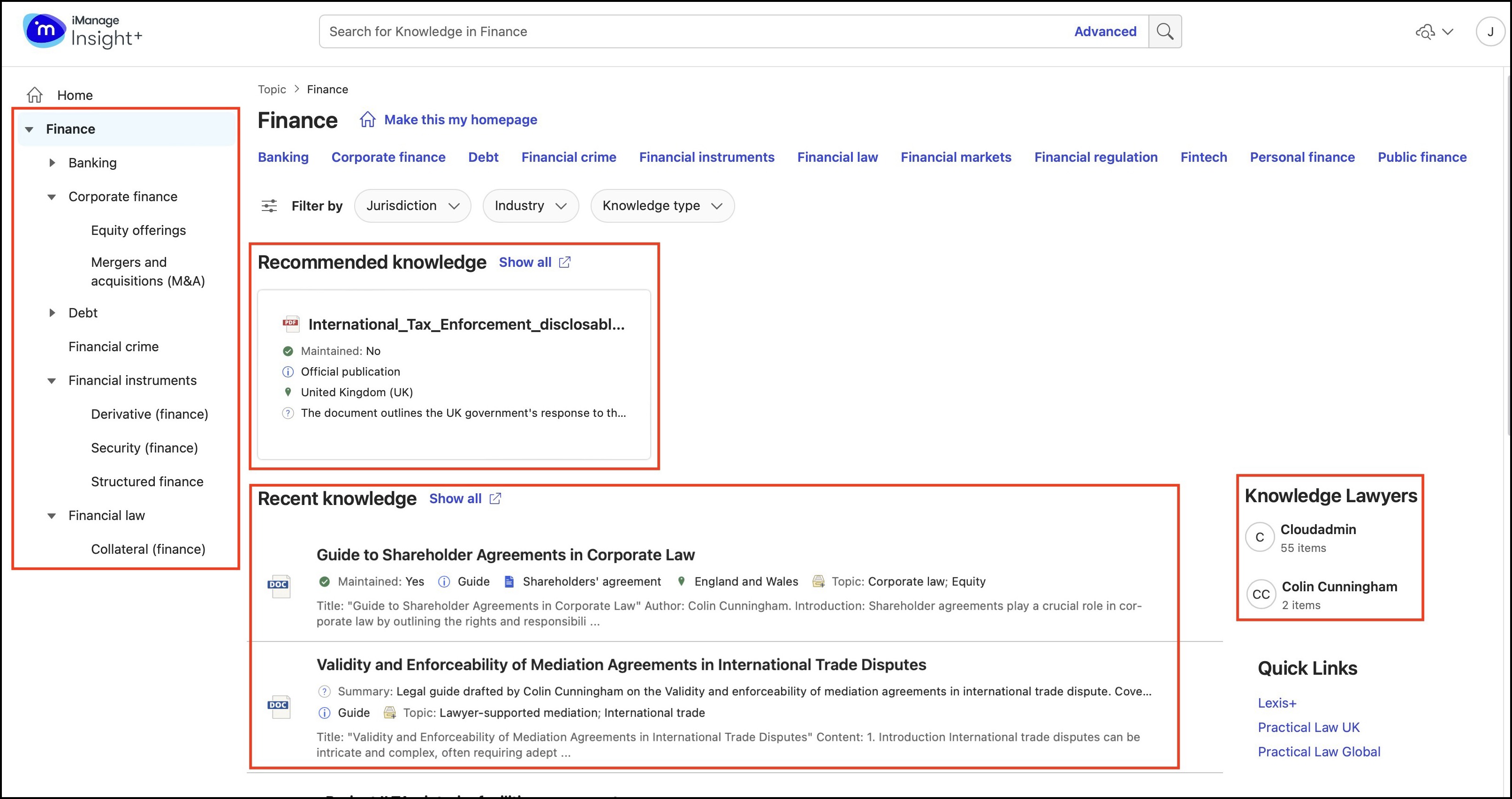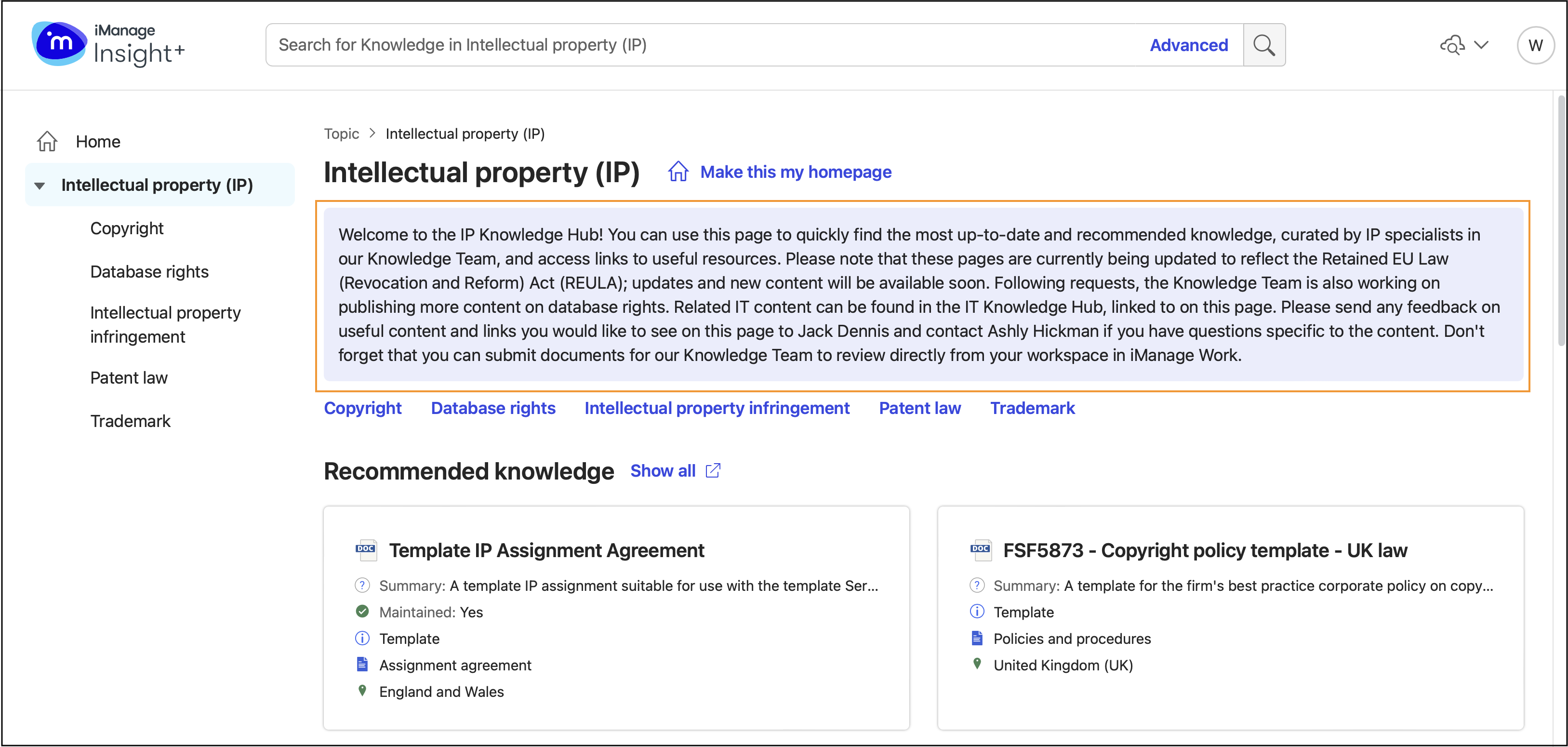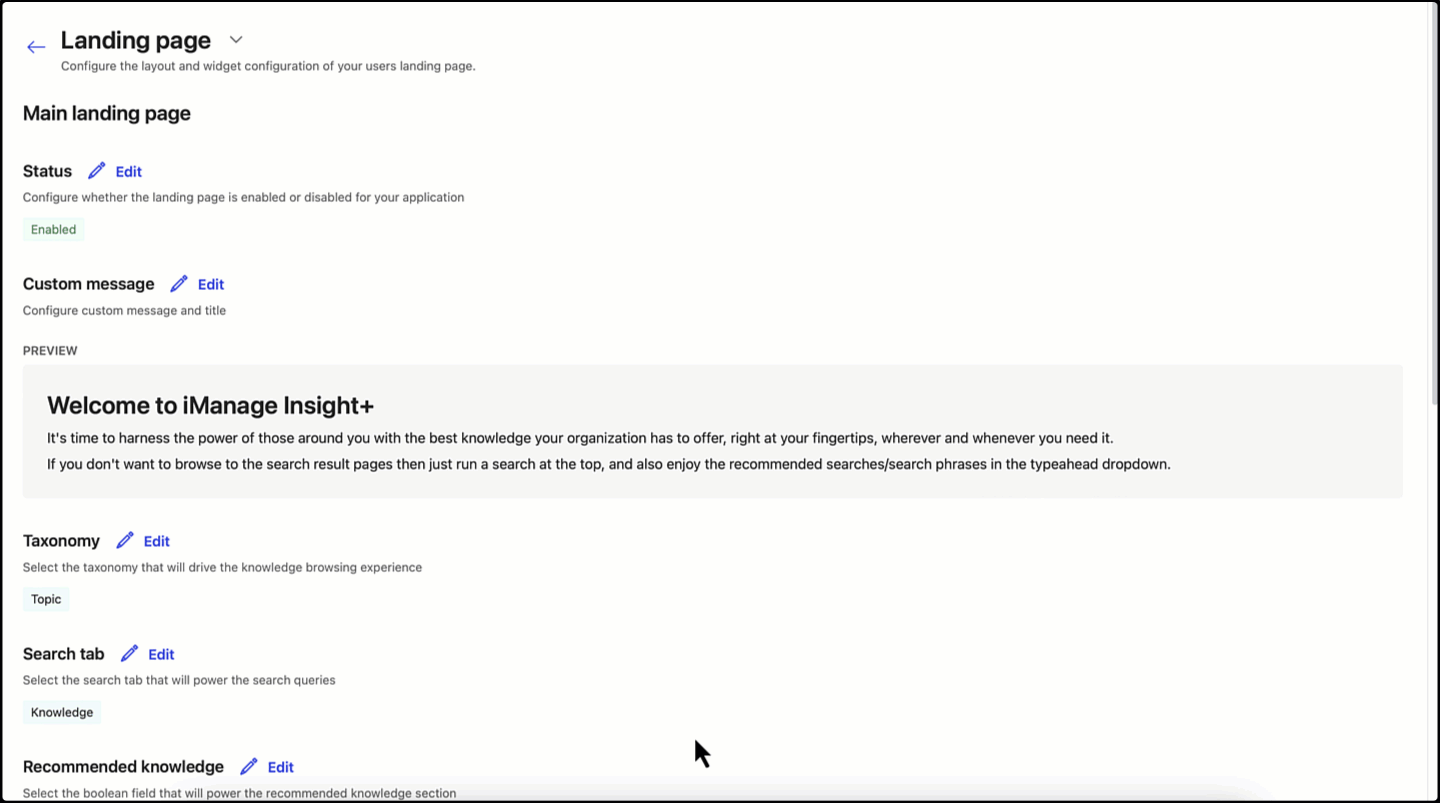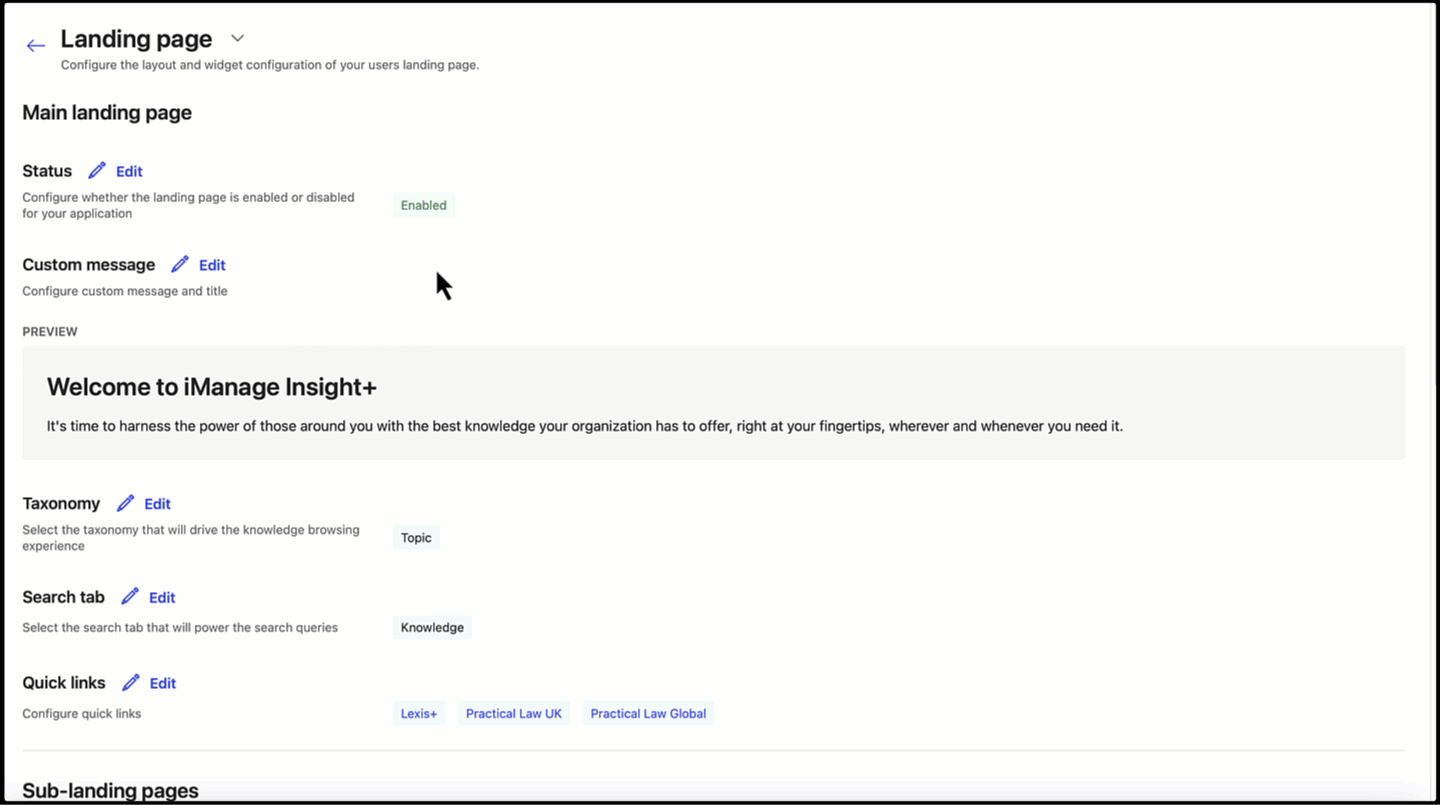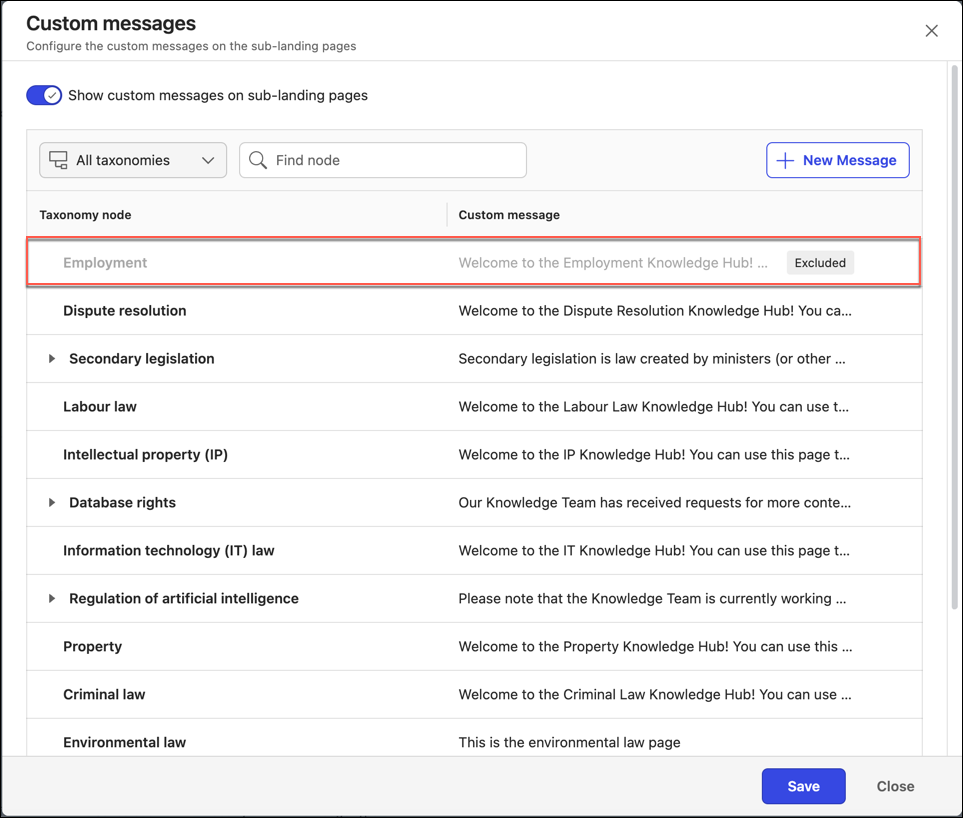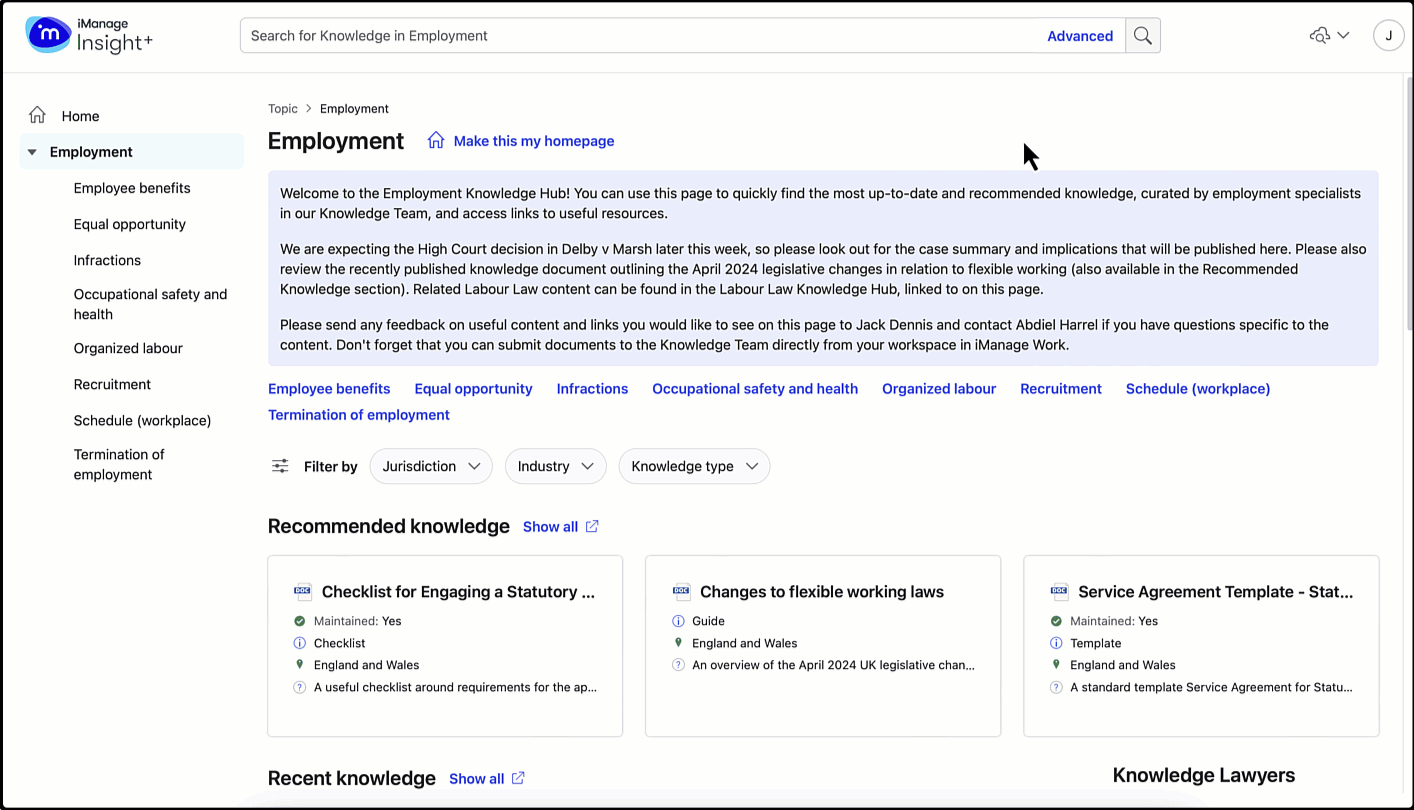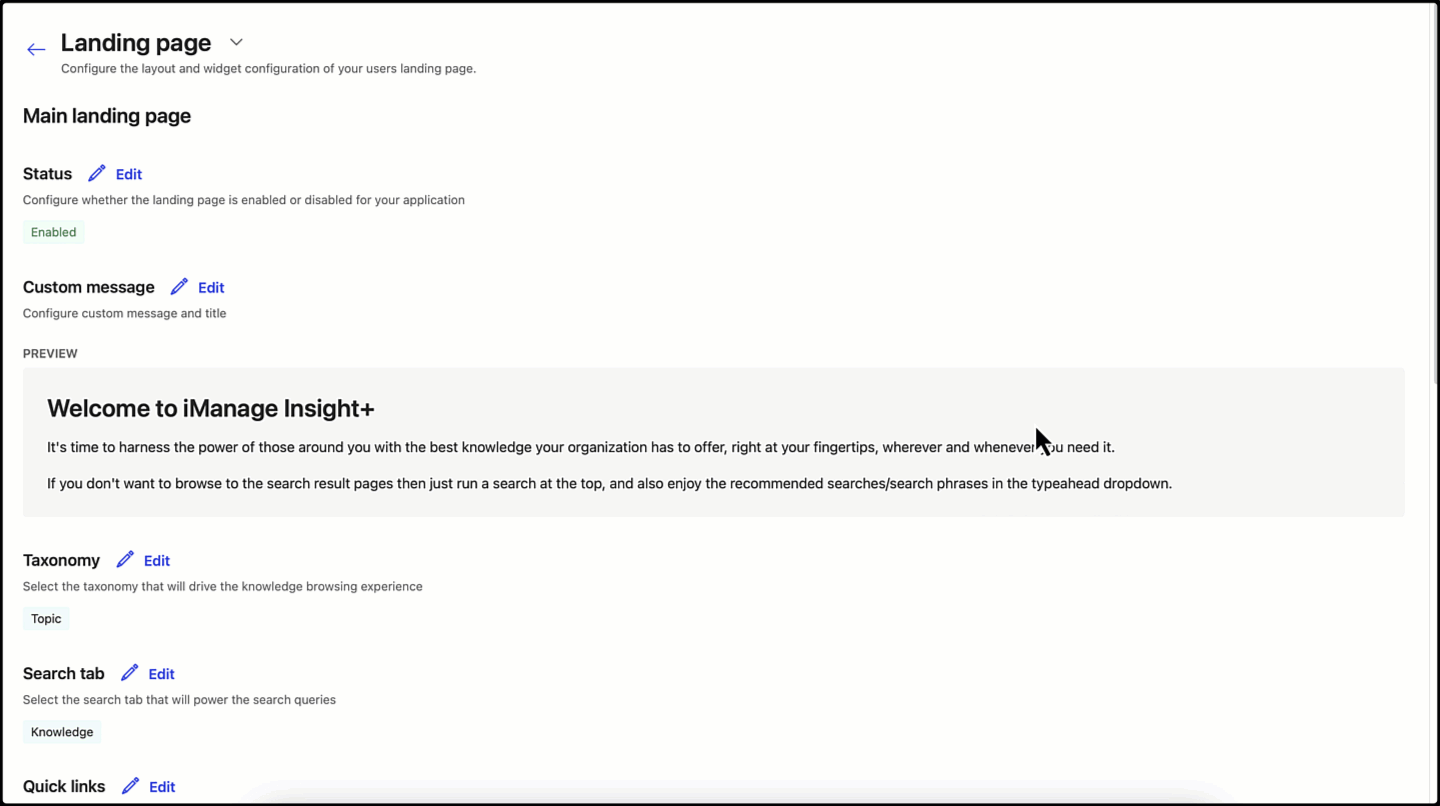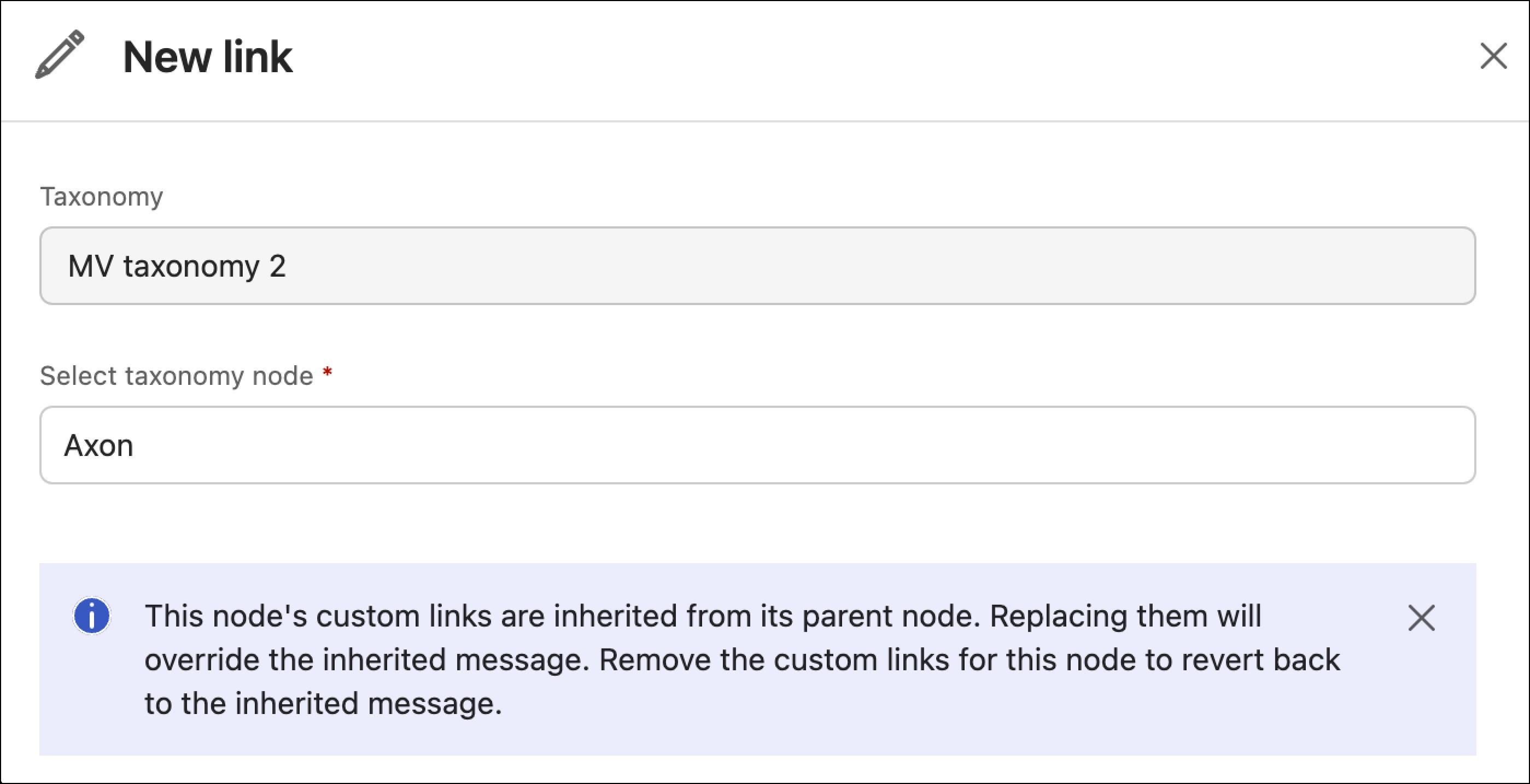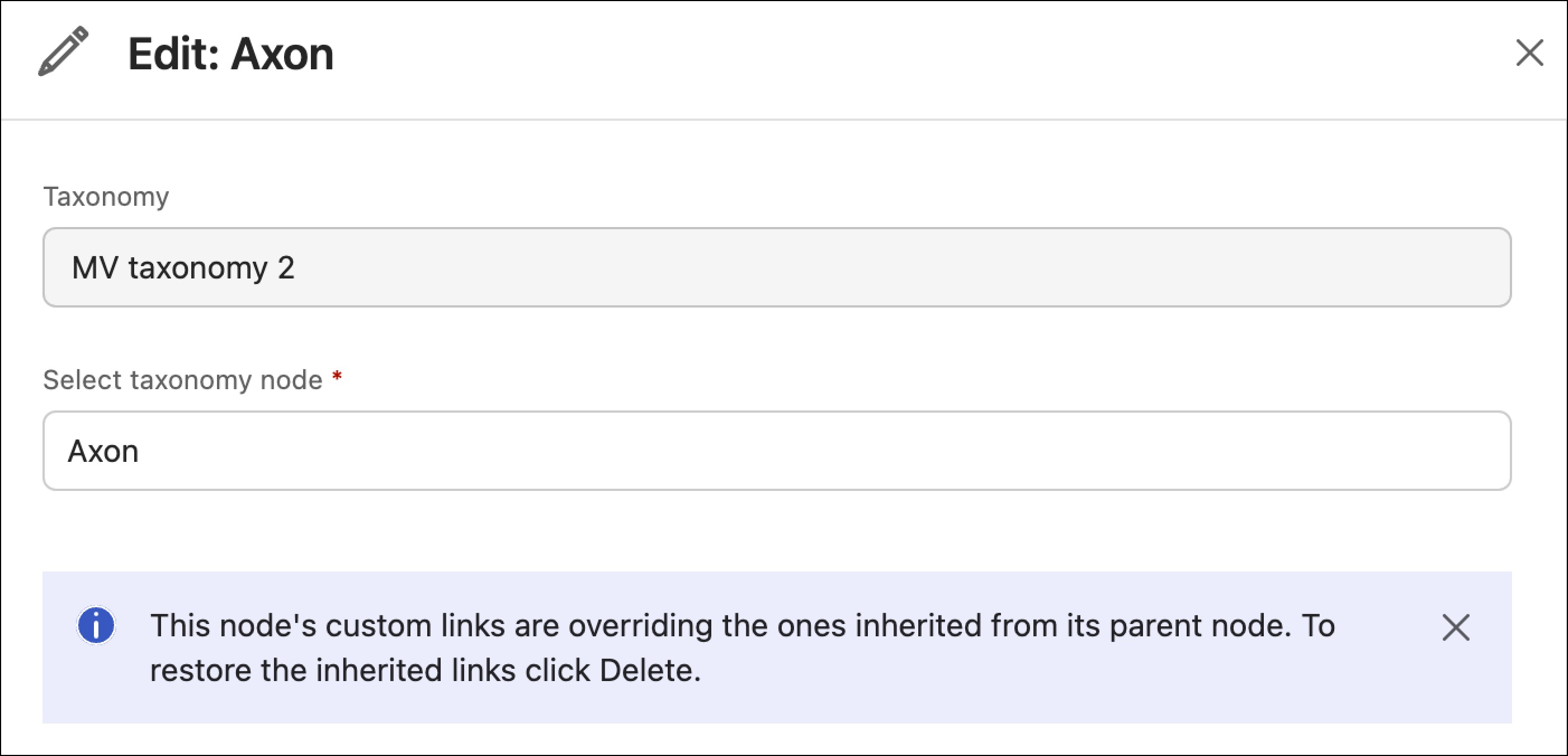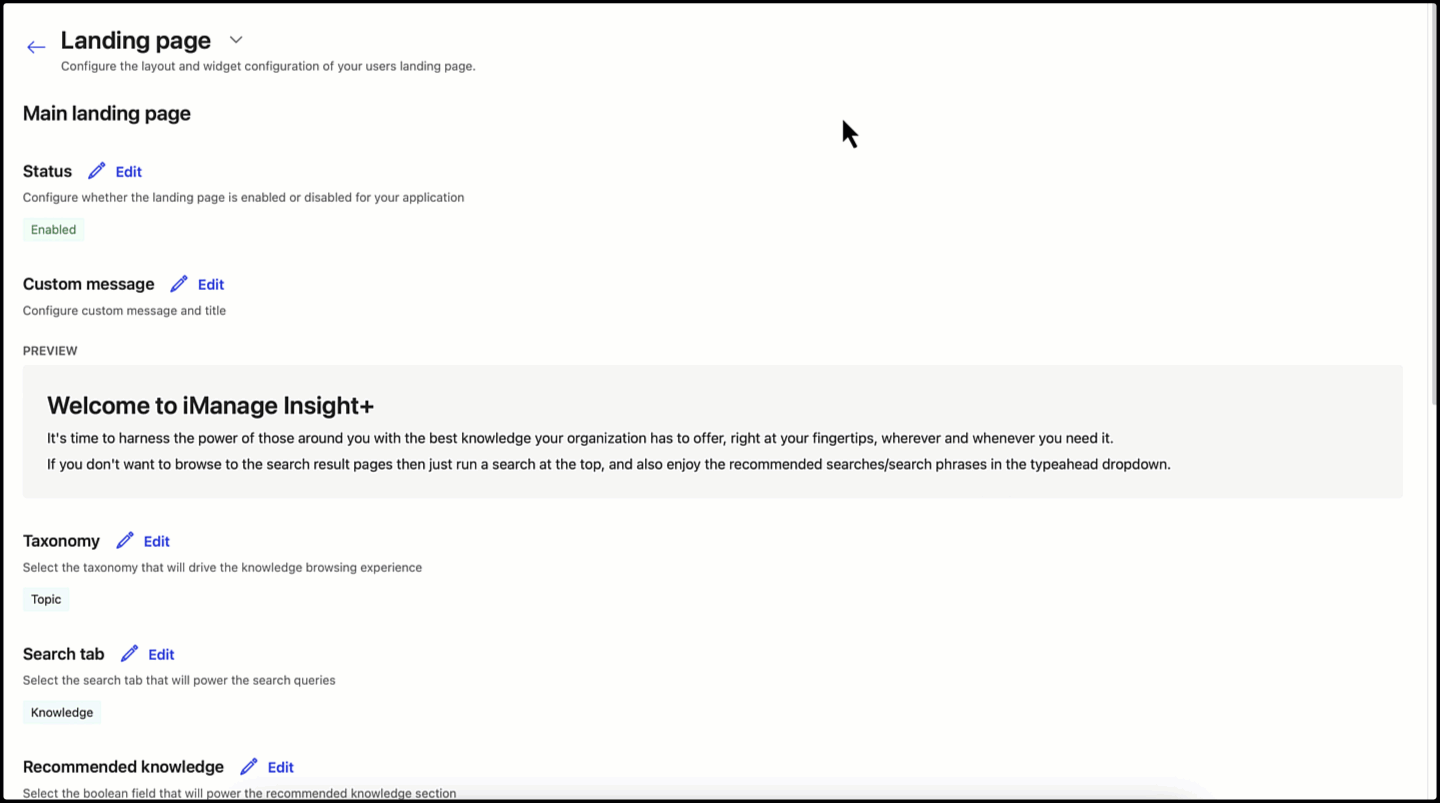When a user selects a value from the main landing page, displayed when they first sign in to iManage Insight+, they’re taken to a sub-landing page that displays information and content related to the value they selected.
Configure a message for each sub-landing page
Custom text can be added to any of the sub-landing pages. You can use this feature for any purpose. For example, as illustrated in the image below, you can use the message to inform the user about what they'll find on the sub-landing page.
While setting up a message to be displayed on any sub-landing page, you can choose to populate all
sub-nodes with the same message, or apply the message to selected nodes or sub-nodes.
To configure a message on any sub-landing page in iManage Control Center, browse to
Extensions > iManage Insight+ > Landing page > Sub-landing pages > Custom messages.
When entering a custom message for a sub-landing page, you're notified when you exceed the
2000-character limit.
Nodes excluded on Landing page are grayed out in Custom messages with an Excluded label. These nodes can only be deleted and not edited.
Adding filters to a sub-landing page
You can configure up to seven filters and choose any taxonomy or look-up field for any sub-landing page. Depending on the taxonomy, you can choose the filters to browse through the sub-landing pages. As best practice, you can set three filters to enhance users' browsing experience.
For example, if you're using Practice area or topic, then we recommend that you configure the Jurisdiction, Industry, and Knowledge type filters.
These filters help your users filter their content accordingly so that they can find the knowledge they need on a particular page without having to always select through a search page.
To configure:
The filters on any sub-landing page in iManage Control Center, browse to Extensions > iManage Insight+ > Landing page > Sub-landing pages > Filters.
Default admin filters, browse to Insight+ Admin page > General. For more information, refer to setting up admin default filters for Landing pages.
Sidebar
In the sidebar on the left side of the page, the full taxonomy for the field connected to the landing page is shown. The selected value (for example, Construction) will be focused, and the taxonomy tree will be opened at this point.
Main content
At the top of the page, a title and breadcrumb trail showing the value you've selected (for example, Home > Construction) is displayed. Below the breadcrumb trail, a list of immediate sub-levels related to the value selected is displayed. For example, for Construction, this could be Building Contracts and Contractors, Statutory Liabilities: Land and Buildings, and so on.
A list of recommended knowledge that matches the relevant value is also shown. Documents are shown here if they match the selected value (for example, Construction) and are flagged with a field of your choice (usually a Recommended or Promoted field you defined in your metadata schema). The count of documents shown is limited by the user’s screen width. To view all recommended knowledge, users can select Show All. If there's no recommended knowledge for a given sub-landing page, no content is displayed.
A list of Recent knowledge is shown below the Recommended knowledge list. You can change the definition of Recent knowledge by specifying a date field in the Admin control panel.
Users can select Show all to be taken to a full list of content matching the given value—for example, Construction. The list of content is a pre-filtered search according to the value selected on the landing page. From here, the user can refine their search as per other iManage Insight+ functionality (for example, to refine to a particular document type).
From a sub-landing page, a user may select any sub-value. For example, a user wishing to view topics in the construction practice group that relate to a sub-value, such as Sustainability and Environment can view all materials that relate to that sub-value and also view a refined list of content on that sub-value.
Contributors widget
A list of people who are related to the documents retrieved for a given sub-landing page, is displayed on the right side of the page. You can select the relevant relationship between the documents and the people. For example, you may wish to select Author as the field if you wish to display a list of authors. Alternatively, you may have a field called Responsibility which defines who's ultimately responsible for the documents (which may be different from the specific individual who authored them).
Quick links
Quick links specified for landing pages are generally displayed on each sub-landing page. You can add quick links on sub-landing pages to important websites or internal resources that are related to the topic of the page. This helps you make useful resources available to your team.
When setting up links for a sub-landing page, you can choose to populate all sub-nodes with the same links or apply links to selected nodes or sub-nodes.
The maximum number of quick links per taxonomy node is limited to 10. If there are more than 10 links, the Add Another button is unavailable in the New link dialog.
Where links are already configured for a node, the Select taxonomy node will be inactive to prevent unintentional overwriting of links.
When creating a child node, if the custom links for the child node are inherited from the parent node, a message is displayed, as shown below.
Figure: Custom links for the child node inherited from the the parentAfter creating a child node with custom links that are different from the parent, you can restore the inherited links.
Figure: Child nodes that are different from the parent node
To configure quick links in iManage Control Center, browse to Extensions > iManage Insight+ > Landing page > Sub-landing pages > Quick Links.
Nodes excluded on Landing page are grayed out in Quick Links with an Excluded label. These nodes can only be deleted and not edited.
